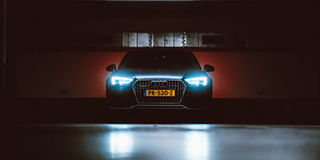What does the law say about LED headlights?

According to the Traffic Act, LED lights — among other illuminations of vegetation-frazzling wattage — are not kosher. PHOTO | BRUNO VAN DER KRAAN | UNSPLASH
What you need to know:
The taillights of the leading car zapped my poor relative’s ocular glands thoroughly and relentlessly to the point he picked up arms and called out the boys in blue asking them in no equivocal terms if such installations on a motor vehicle were legal, because they sure weren’t safe.
Blinding the person driving behind you is not only antisocial, it increases the likelihood of road accidents as well because he will ram you if he can’t see.
According to Cap 403 Section 23 (1) of the Traffic Act, LED lights — among other illuminations of vegetation-frazzling wattage — are not kosher. The limit in terms of lumens, candelas, watts or units of measurement used to define quantities of light has not been specified, but it does stipulate that “vehicles should have two lights at the front while motorbikes should have one light”, and that the headlights should be “white or yellow” and “capable of illuminating 100-150 metres ahead”. That is not very helpful since I could instal downward-facing floodlights with a reach of exactly 149 metres, but I could still melt your eyeballs if you face me while positioned anywhere within that unfortunate radius.
SHAKEDOWNS
The law should be more specific and use standard scientific units to prevent random shakedowns, because random shakedowns are what result from such ambiguous statutes. However, when you get to Section 23 (3), things take a turn for the interesting.
This part states: “Every motor vehicle … shall carry two lamps at the rear of the vehicle of such intensity as to indicate clearly within a distance of not less than 200 metres … its presence on the road to traffic approaching from behind …” [emphasis mine].
This, to someone not inclined towards in-depth analysis of syntax (which is the vast majority of people out there), implies that the rear lamps should illuminate further compared to the front. That is not exactly accurate, the front lamps are meant to make you see, the rear ones are meant to make you be seen, however, the actual twist in the tale stems from the following anecdote. The National Police Service was last year compelled to clarify the above regulations following a social media storm kicked up by someone well known to me: we went to the same high school, and what’s more, we are relatives (the details of this connection are irrelevant to this story).
KERFUFFLE
This acquaintance was, one day, driving home and found himself behind a vehicle that didn’t have brake lights as much as it had lasers of such intensity as to send James Bond into early retirement citing a hazardous work environment. The taillights of the leading car zapped my poor relative’s ocular glands thoroughly and relentlessly to the point he picked up arms and called out the boys in blue asking them in no equivocal terms if such installations on a motor vehicle were legal, because they sure weren’t safe. Blinding the person driving behind you is not only antisocial, it increases the likelihood of road accidents as well because he will ram you if he can’t see.
The National Police Service was not backward about coming forward in strong agreement with my clansman, and so they said, “Aww, hell no! That is illegal”. They then proceeded to quote chapter and verse from The Book Of Laws, laws which govern the behaviour of any Old Testament enthusiasts who may take the “Let there be light” mantra to uncomfortable extremes. Strangely, it gives light intensity in terms of distance, rather than lumens/candelas/ temperature, but the irony is the stipulated distance for the rear lamps is twice that of the front ones. Funny, huh? More so given that this whole kerfuffle stemmed from someone who fell victim to overpowered rear lights.
SECURITY GRADE
(I reiterate, the rear lamps are meant to be seen, not to light up the earth behind you.]
So, long story short: LEDs are not illegal (per se). A lot of us have them on our cars, the problem arises when your LEDs are of the cancer-inducing, maximum-security grade that can also serve duty in a tanning salon. Use your discretion and stay away from these.
Addendum: Cap 403 also specifies that the lamps should be two apiece front and rear at (or close to) the ends of the car on either side except for the number plate light which is placed wherever the rear number plate is. This means the police have the right to give you grief if you have extra lights installed in other positions such as within the grille, on the roof or above the front number plate.




